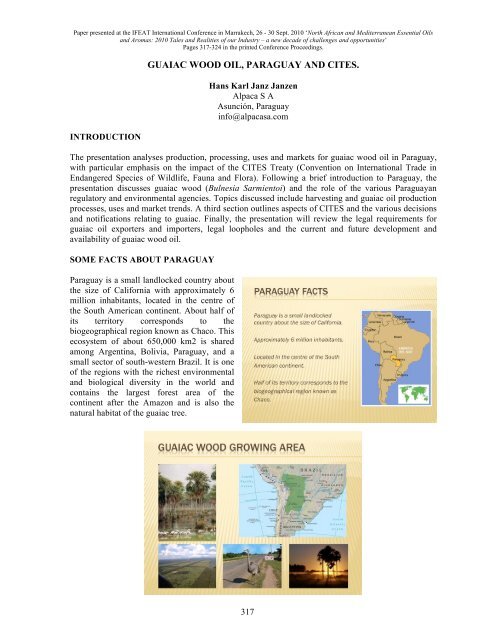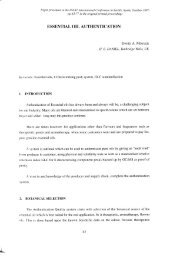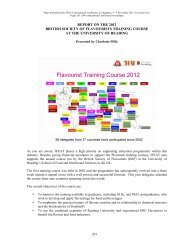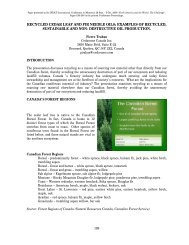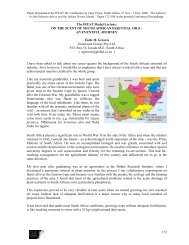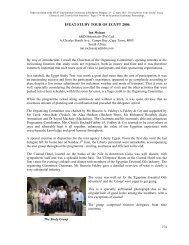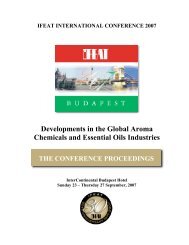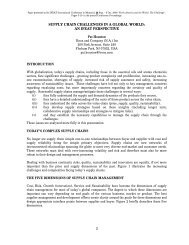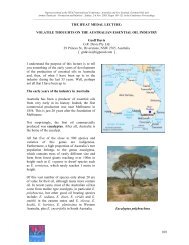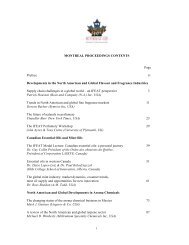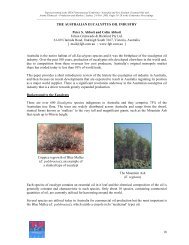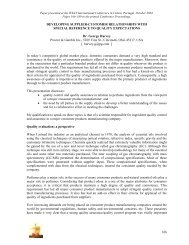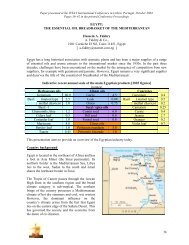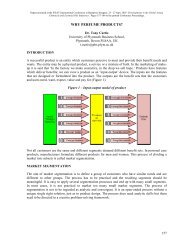Janzen - Guaiac wood - IFEAT
Janzen - Guaiac wood - IFEAT
Janzen - Guaiac wood - IFEAT
Create successful ePaper yourself
Turn your PDF publications into a flip-book with our unique Google optimized e-Paper software.
Paper presented at the <strong>IFEAT</strong> International Conference in Marrakech, 26 - 30 Sept. 2010 ‘North African and Mediterranean Essential Oils<br />
and Aromas: 2010 Tales and Realities of our Industry – a new decade of challenges and opportunities’<br />
Pages 317-324 in the printed Conference Proceedings.<br />
INTRODUCTION<br />
GUAIAC WOOD OIL, PARAGUAY AND CITES.<br />
Hans Karl Janz <strong>Janzen</strong><br />
Alpaca S A<br />
Asunción, Paraguay<br />
info@alpacasa.com<br />
The presentation analyses production, processing, uses and markets for guaiac <strong>wood</strong> oil in Paraguay,<br />
with particular emphasis on the impact of the CITES Treaty (Convention on International Trade in<br />
Endangered Species of Wildlife, Fauna and Flora). Following a brief introduction to Paraguay, the<br />
presentation discusses guaiac <strong>wood</strong> (Bulnesia Sarmientoi) and the role of the various Paraguayan<br />
regulatory and environmental agencies. Topics discussed include harvesting and guaiac oil production<br />
processes, uses and market trends. A third section outlines aspects of CITES and the various decisions<br />
and notifications relating to guaiac. Finally, the presentation will review the legal requirements for<br />
guaiac oil exporters and importers, legal loopholes and the current and future development and<br />
availability of guaiac <strong>wood</strong> oil.<br />
SOME FACTS ABOUT PARAGUAY<br />
Paraguay is a small landlocked country about<br />
the size of California with approximately 6<br />
million inhabitants, located in the centre of<br />
the South American continent. About half of<br />
its territory corresponds to the<br />
biogeographical region known as Chaco. This<br />
ecosystem of about 650,000 km2 is shared<br />
among Argentina, Bolivia, Paraguay, and a<br />
small sector of south-western Brazil. It is one<br />
of the regions with the richest environmental<br />
and biological diversity in the world and<br />
contains the largest forest area of the<br />
continent after the Amazon and is also the<br />
natural habitat of the guaiac tree.<br />
317
Main economic activities.<br />
Paraguay’s trade is heavily dependent on its<br />
big neighbours (Argentina and Brazil). The<br />
main income is from commodity agriculture<br />
and cattle meat exports. It is the world’s 4th<br />
largest soybean exporter and 6th largest<br />
soybean producer behind USA, Brazil,<br />
Argentina, China and India, in that order. To<br />
achieve this, lots of forest land had to be<br />
transformed into ploughed fields. Even so<br />
about 40% of the population is below the<br />
poverty line.<br />
Main essential oils of Paraguay – relative importance of guaiac.<br />
The main essential oils produced in Paraguay are: petitgrain, guaiac, arvensis mint and cabreuva.<br />
There are also much smaller crops of palma rosa, citriodora, vetiver and citronella oils. <strong>Guaiac</strong> oil<br />
corresponds to about 30% of Paraguay’s total essential oil sales (in tons).<br />
GUAIAC WOOD<br />
a) <strong>Guaiac</strong> <strong>wood</strong> - brief introduction<br />
The <strong>Guaiac</strong> tree Bulnesia Sarmientoi is locally<br />
known in Spanish as palo santo which means<br />
holy tree, it grows only but very abundantly<br />
throughout the sparsely populated Gran<br />
Chaco. The tree is sometimes crocked; its<br />
<strong>wood</strong> has greenish stripes and a fragrant resin.<br />
It reaches a height of 10 metres and the trunk<br />
can have a diameter of 80 cm. The name “holy<br />
tree” says it all about what Paraguayans feel<br />
for this species, which has a very unique and<br />
distinctive place in Paraguay’s general culture.<br />
It is highly valued for the many healing powers<br />
attributed to infusions brewed from of its bark,<br />
crust or leaves. It is used by traditional healers<br />
for many generations to heal gastric pain,<br />
syphilis, leprosy, gout, rheumatism, arthritis,<br />
lumbago and skin diseases. Indigenous groups<br />
also use the <strong>wood</strong> for craftwork. The tree is one<br />
318
of the hardest and heaviest of <strong>wood</strong>s (1100-1280 kg/m3); it is very strong and decay resistant, even<br />
underground, because of its resin content. The <strong>wood</strong> is used to make durable poles, beams, posts and<br />
pillars for construction in the Chaco region (especially in Mennonite communities). In the past two<br />
decades the <strong>wood</strong> has been exported to manufacture special pipe bushings which are used for ships of<br />
shallow, medium and deep draught. Demand for guaiac flooring <strong>wood</strong> has been strong in the Asian<br />
and North American markets.<br />
b) Local legislative and regulatory environment regarding guaiac <strong>wood</strong>.<br />
There are two main administrative institutions and one judicial office involved in guaiac <strong>wood</strong><br />
regulation.<br />
• SEAM (General Environmental Regulatory Agency)<br />
In charge of analyzing and granting general investment permits such as: logging, forest clear<br />
cut, large scale farming, cattle rising, industrial facility compliance, national infrastructure<br />
construction, mining, drilling and any important investment project that could have any<br />
significant impact on the environment. The relationship is strictly between the government and<br />
private land owners. Permits must be renewed every two years. SEAM is also Paraguay’s<br />
CITES permit issuing Management Authority.<br />
• INFONA (National Forest Institute)<br />
In charge of technically monitoring all forest harvesting, sawmill functioning and<br />
industrialized timber transport affairs. Its specific purpose is to protect forest resources from<br />
being over exploited. It regulates internal timber commerce and export issues. It is also the<br />
instigator of administrative claims. If a contentious event is considered a crime, the case is<br />
referred to the Fiscalia for prosecution.<br />
• FISCALIA AMBIENTAL (Environment Attorney General)<br />
In charge of state criminal prosecution against environmental crimes and felonies. The<br />
minimum jail time for guilty convicted environmental crime is 7 years. It is a feared institution<br />
due to its provisional detention powers. It is better to have paperwork in order.<br />
c) <strong>Guaiac</strong> timber harvest and guaiac oil production process and yields.<br />
• <strong>Guaiac</strong> timber harvest.<br />
Landowners can initiate harvesting<br />
only after having obtained clearance of<br />
the SEAM and INFONA. Usually<br />
owners hire contractors to do the<br />
harvesting and then sell the logs to the<br />
local saw mills. Alternatively, they sell<br />
the complete logging rights to other<br />
timber companies. Once the trees are<br />
cut with chain saws, tractors pull the<br />
logs out on tiny roads into larger clear<br />
fields. Afterwards the logs are loaded<br />
onto trucks which transport them to<br />
sawmills or to distillation units.<br />
319
• <strong>Guaiac</strong> oil production process.<br />
In the early 1900’s the logs were<br />
exported to Europe for oil distillation.<br />
After World War 2, distillation has<br />
been done locally. The oil is obtained<br />
by steam distillation of shredded<br />
<strong>wood</strong> chips of the Bulnesia<br />
Sarmientoi. It is pale yellow and solid<br />
at room temperature with a strong<br />
<strong>wood</strong>y scent. In our case (ALPACA<br />
S.A.), only uses timber scraps or logs<br />
of no use to the saw mills, this raw<br />
material is mechanically shredded<br />
into small chips the size of beans.<br />
These <strong>wood</strong>chips are loaded into<br />
autoclave stainless steel distillation<br />
stills. Steam is passed through the<br />
layer of chips, which is afterwards<br />
cooled in condensers and separated in<br />
florentine vase units. The difference<br />
from other essential oils distillation is<br />
that care must be taken in order not to<br />
cool the oil too much; as guaiac oil is<br />
solid at room temperature. In our case<br />
we have the entire florentine vase<br />
submerged in a “mary bath”. The oil<br />
yield is around 3.5 - 4 %.<br />
d) Production and processing structure in Paraguay.<br />
About 500 people are directly employed through the entire production chain involving guaiac timber<br />
and the guaiac oil industry. There are 4 main guaiac oil manufacturers. The general steam distillation<br />
process is the same for each one, with some variations regarding water treatment, total distillation<br />
times, still size, etc. The main difference is in the raw material each uses.<br />
It is perfectly legal to cut healthy mature trees<br />
for the sole purpose of essential oil<br />
manufacturing. However, it is environmentally<br />
friendlier and economically wise to harvest<br />
guaiac, first for its timber value, using only the<br />
byproducts such as branches, fallen or useless<br />
trees, sawmill leftover boards and sawdust as<br />
the raw material for essential oil distillation.<br />
Manufacturers export the oil directly. Paraguay<br />
is the world’s sole producer and exporter of<br />
guaiac<strong>wood</strong> oil.<br />
320
e) <strong>Guaiac</strong> oil uses, major markets, statistics and trade trends.<br />
• Uses<br />
The two main components of guaiac<br />
oil are “Guaiol and Bulnesol”. <strong>Guaiac</strong><br />
oil is used in the soap and varnish<br />
industry but mainly as a fixative in<br />
perfumes. Guayil acetate is also a<br />
popular product made from the oil<br />
and is also used as a fixative.<br />
• Major markets<br />
Spain, France, USA, India, Switzerland and Germany are the main markets for guaiac oil.<br />
321
• Statistics and trade trends<br />
Only a few hundred kilos of guaiac essential oil are sold locally. From the statistic chart we<br />
can confirm a steady increase in sales from 2005 to 2008. In 2009 sales decreased about 20%<br />
due to global destocking. This year up to July total sales had already surpassed all of last<br />
year’s figures. After Paraguay receives CITES’s blessing we should finish the year easily<br />
surpassing sales of 2008 and reach or pass 200 tons.<br />
3) CITES (CONVENTION ON INTERNATIONAL TRADE IN ENDANGERED SPECIES OF<br />
WILD LIFE FAUNA AND FLORA)<br />
a) Description of CITES.<br />
CITES is an international treaty that has been ratified by 175 countries<br />
since it first came into force in 1975. Its aim is to ensure that<br />
international trade in specimens of wild animals and plants does not<br />
threaten their survival.<br />
CITES regulates international wildlife trade through a system of permits<br />
and certificates to ensure that trade in listed wildlife (including plants),<br />
including their parts and products is legal and does not threaten their<br />
survival in the wild. Species may be listed in one of three appendices,<br />
each of which provides different levels of protection.<br />
b) Description of the CITES Appendix list.<br />
Appendix I: Includes species threatened with extinction. Trade in specimens of these species is<br />
permitted only in exceptional circumstances.<br />
Appendix II: Includes species that are currently not threatened with extinction, but in which trade<br />
must be controlled in order to avoid utilization incompatible with their survival.<br />
Now including Bulnesia Sarmientoi (<strong>Guaiac</strong><strong>wood</strong>).<br />
Appendix III: Contains species that are protected in at least one country, which has asked other,<br />
CITES Parties for assistance in controlling the trade.<br />
c) Decisions and notifications of the Conference parties to CITES.<br />
September 29th, 2003: Paraguay decided to enter a voluntary moratorium on all trade in wildlife<br />
under CITES.<br />
February 12th, 2008: Bulnesia Sarmientoi (<strong>Guaiac</strong><strong>wood</strong>) was listed in Appendix III, officially<br />
sponsored by Argentina.<br />
August 10th, 2009: Paraguay’s voluntary moratorium was lifted (by CITES-Geneva) with regard to<br />
trade in specimens of Appendix III species.<br />
322
March 19th, 2010: At the 15th meeting of the Conference of the Parties (CoP15) it was resolved to<br />
list Aniba Rosaedora (Brazilian Rose<strong>wood</strong>) sponsored by Brazil and Bulnesia Sarmientoi sponsored<br />
by Argentina in Appendix II.<br />
August 28th, 2010: A CITES delegation arrived in Paraguay to make assessments towards the<br />
complete lifting of its moratorium.<br />
d) Current implications for guaiac oil under CITES.<br />
The current listing for guaiac covers logs,<br />
sawn <strong>wood</strong>, veneer sheets, ply<strong>wood</strong>, powder<br />
and extracts.<br />
The Cites Management Authority of<br />
Paraguay (SEAM) has told us that it has<br />
submitted all the paperwork necessary for the<br />
voluntary moratorium to be completely lifted<br />
on species listed in appendix 1 and 2. We are<br />
eagerly waiting for the head office of CITES<br />
in Geneva to notify our government officials,<br />
so we can start exporting again.<br />
4) FINAL COMMENTS<br />
a) Requirements for guaiac oil importers and exporters.<br />
• a.1) An export permit or re-export certificate issued by the<br />
Management Authority of the exporting State is required. An<br />
export permit may be issued only if the specimen was legally<br />
obtained and if the export will not be detrimental to the survival<br />
of the species. A re-export certificate may be issued only if the<br />
specimen was imported in accordance with the Convention.<br />
• a.2) No import permit is needed unless required by national<br />
law. The import of any specimen of a species included in<br />
Appendix II shall require the prior presentation of either an<br />
export permit or a re-export certificate.<br />
b) Legal loopholes, distinctions between “extract” and “essential oils”.<br />
After first reading the list issued by CITES I was very tempted to challenge whether guaiac oil was<br />
actually covered by the term “extracts” that is regarded in the CITES # 11 annotation. My doubts were<br />
cleared after carefully reviewing a letter from the European Federation of Essential Oils regarding the<br />
inclusion of Bulnesia Sarmientoi in Appendix 2. It states as follows:<br />
“Extract” is an umbrella term comprising derivatives like the extract, the essential oil,<br />
the oleoresin and/or any form of distillation or extraction from the source material. This<br />
view is commonly shared by trade and non-officially also by national authorities.<br />
Source: (LD//EFEO CITES INFO MAY 19/2010).<br />
The term “EXTRACTS” covers all types of derivatives obtained by any extraction method (solvent,<br />
steam, pressed, etc). The term Essential oil only covers those obtained by steam distillation.<br />
323
Current status and future availability of guaiac oil.<br />
I am firmly convinced that CITES will notify<br />
the Parties of Paraguay’s moratorium lifting,<br />
and guaic oil exports should restart between<br />
October and December of this year. I also<br />
personally believe that guaiac is being<br />
sustainable exploited and that it will be<br />
around for many decades to come. After an<br />
initial worry about guaiac being placed in<br />
CITES I thought to myself that exporters and<br />
importers should not feel intimidated by the<br />
CITES certificate obligation. Yes, it is another<br />
product whose paperwork has increased. But<br />
considering the fact that South America in<br />
general and specifically Paraguay’s cattle<br />
ranching and agricultural frontiers are being<br />
extended, it is only natural, and why not say healthy, that this process and the natural occurring species<br />
used; should be monitored. After all, we all want to be part of sustainable development respecting the<br />
environment. If we have a CITES certificate for guaiac oil, which by the way is not freely handed out<br />
as a pizza pamphlet, then we are a guaranteed that the product is being sustainably exploited.<br />
Hans Karl Janz <strong>Janzen</strong> is Executive Director of Alapaca, S.A., a company he cofounded<br />
in 1998 to undertake essential oil distillation. He was born in Paraguay<br />
and following a high school education in Canada he took a law diploma at the<br />
National University of Asunción in Paraguay, specializing in Paraguayan<br />
environmental regulations. Prior to establishing Alapaca S.A. he worked in the<br />
sugar cane, timber and steel sectors in Paraguay. He speaks several languages<br />
and is a certified lawyer and civilian pilot. Hans Karl is President of the<br />
Cooperativa Jejui Guasu, an organization dedicated to improving the living<br />
conditions of Paraguayan aromatic plant farmers.<br />
324


